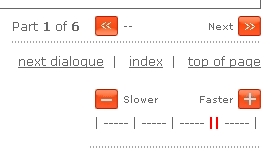Learning Strategies
I will discuss my ideas on "how to best learn Russian, or any language", elsewhere. Here, I simply want to help give you a clear idea how to use our material most effectively.
First of all, it's much better to do a little every day, and even 5-10 minutes 3 times a day is better than a long session once a week. Language learning is a 'physical process' and small 'daily workouts' will provide much better results than occassional 'big workouts', which may just leave you with a headache.
Second, it's not necessary to understand everything all the time. You will want to go over most material several times, and each time your main focus should be on listening and speaking. After getting sufficient 'physical practice', you can then review the grammar aspects so that it all becomes clearer in your conscious, logical mind. Remember though, your conscious mind is the 'slow learner'. Your 'intuitive mind' is capable of learning much, much quicker, so simply relax, let go of your desire to understand and control everything, and let it happen.
Progression of Material and 'User Controls'
The image below shows how we've set up the 'controls' to help you progress through the material as effectively and efficiently as possible. We've tried to give you complete control over your own learning but also give you a very clear path to follow.

We've also tried to keep everything 'clean and simple'. The simplest 'path' is to simply click 'Next' and progress through all the material. This will take you through the material in an order that we think is most effective, and isn't sequential through any particular 'series' of material.
To continue sequentially within a series, you can click 'next dialogue' and you can always go back to the main index in order to select any particular material that you want to work on next. Each page also has a 'mini index' of the material and exercises for that series.
We also wanted to create several 'paths' for you to follow depending on how fast you're learning the material. Thus, our 'speed control' which allows you to adjust your 'speed' from 1 - 5. The top speed is great for review and geniuses. Every detail gets covered but there's very little review or repetition. S4 (shown) moves along quite quickly and will likely be rather quick for most learners.
Clicking 'Slower' or 'Faster' will take you the 'Next' page but at an adjusted 'speed'.
It's perhaps easiest to think of it in comparison to travelling from London to Moscow. S1 is like walking. You get to take in all the scenery, it's very pleasant, but it will take you quite a while to get there. S2 is like riding a bike. We like to consider S3 as 'the scenic route'. S4 is the 'expressway' and S5 is flying or a high-speed train.
I've never liked programs which left me wondering what grammar aspect to study next, or programs that left 'gaps' in my learning by moving too quickly or jumping over important aspects. Each 'path' in our program covers every aspect, and by allowing the learner to choose the speed, they're not limited to a slower speed than necessary or struggling to keep up with something that's moving too quickly for them. What I want in a program is to simply keep moving forward, learning more and more, and my only decision is 'slow down', 'speed up' and 'just right'.
If you have any questions, or would like more information, please email me, Brian. ( gmaebc@gmail.com )
top of page

